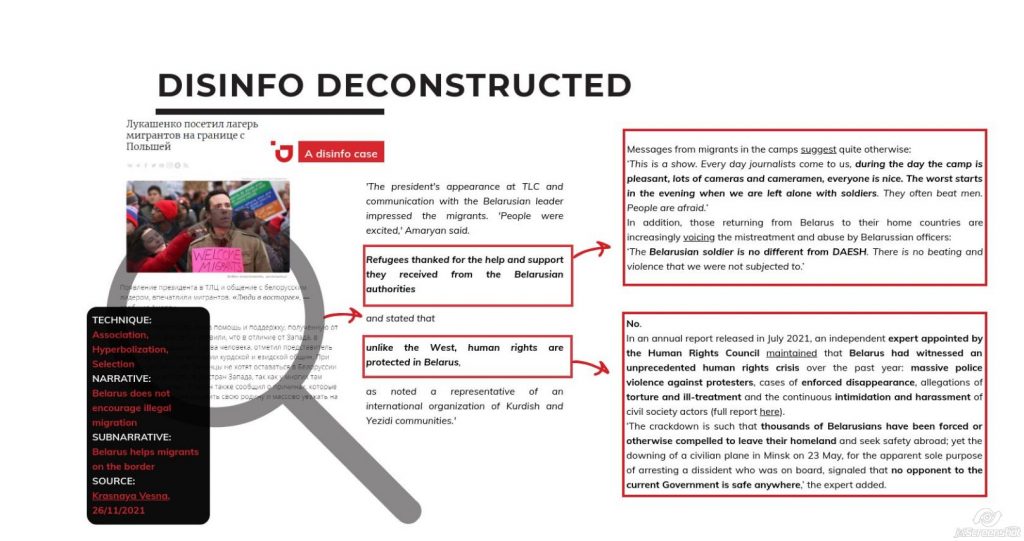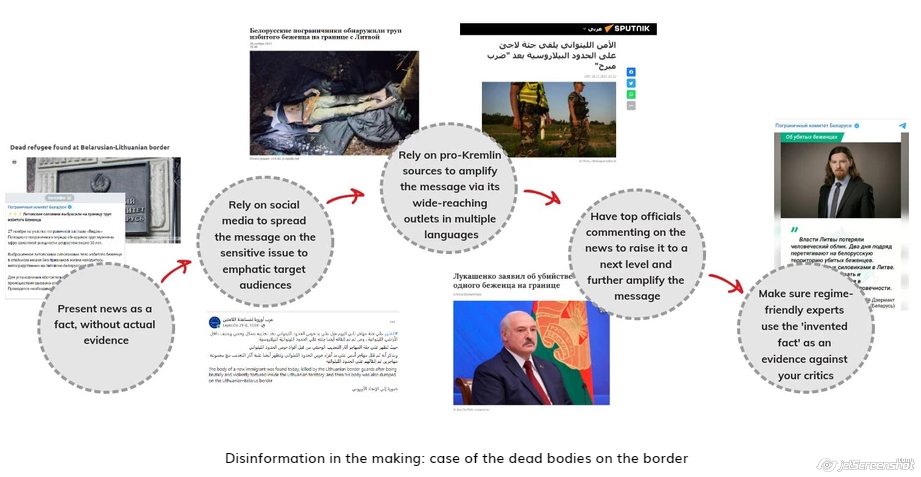By DebunkEU.org
A major increase in tension on the border with Belarus in the beginning of November has accelerated the spread of false claims – Lithuania was targeted with accusations of dumping dead bodies on the border and fabricating videos. In a cynical attempt to use the migrants as a means of spreading propaganda, Alexander Lukashenko gave a speech presenting Belarus as a beacon of human rights on the contrary to the cruel West.
Case #1: “Lithuania and Poland use fascist methods against refugees”
Commenting on the allegations about a dead body of a migrant found next to Lithuanian/Belarusian border during his appearance on Belarus 1, Russian military & defense contributor, retired colonel Viktor Baranets said that ‘this is already very close to fascism. Getting rid of a corpse, dumping it on the other side of the border – this exposes the disgusting face of another of your neighbors’.
He then added that ‘only people with a fascist mind or people who are filled with beastly hatred towards Belarus can do such a thing to dead bodies. Where are these universal values gone? They are buried in frozen ground on the border with Poland, Latvia and Lithuania.’
To prove the inhumanity of the Baltic countries and Poland, Baranets (an author of several books, including Yeltisn and His Generals and Special Operation Crimea-2014, who also used to assist Vladimir Putin in one of his electoral campaigns) employs the allegations by the Belarusian State Border Committee. They announced that Lithuanian forces have been dumping dead migrant bodies onto Belarusian territory from Lithuania, which has not been confirmed by any official investigation.
In turn, the Lithuanian State Border Guard Service said it had no information about the corpse of the migrant allegedly found on the Belarusian side of the border, and there have been no recent cases of migrant groups being denied entry to Lithuania at the location approximately indicated by the Belarusian side (the last exclusion there was recorded on 16 November).
The news about the body of the migrant, discovered on November 27 and announced the next day, was soon amplified by pro-Kremlin media, and spread throughout migrant-linked social media and online resources. In parallel, the piece of news was attributed new ‘details’ as to the migrant being brutally beaten by Lithuanian officers, whilst Belarusian state media made additional reporting on alleged eyewitnesses.
As another body was found, Alexander Lukashenko deemed it necessary to elaborate on the issue at a Defense Ministry meeting on November 29, claiming that ‘the bastards went as far as killing people.’ The next day, several regime-friendly experts took the allegations to a next level, speaking about fascist methods and crimes against humanity committed by Lithuania.

Disinformation in the making: case of the dead bodies on the border
Case #2: “Lukashenko is ready to help the migrants”
On November 26, Alexander Lukashenko visited a warehouse in Bruzgi sheltering the migrants from the Middle East and North Africa, who had earlier tried to storm the Polish border under the control of the Belarusian security forces. The visit was broadcasted live by the state television, amplified broadly by the official Minsk media and Kremlin-aligned sources, as well as shared by migrant-linked social media groups/pages.
Not only was the visit a cynical attempt to use the migrants for propaganda purposes (targeting several audiences, from the domestic one to migrant media, social and traditional), but it was also a delivery of a targeted message both to the West and migrant-communities (those who are already stranded first of all) that Lukashenko is not giving up: he intends to further use migrants at the borders with EU members as a means to pressure the bloc and create tensions. ‘If anybody wants to go west – that is your right. We will not try to catch you, beat you, and hold you behind barbed wire,’ Lukashenko said.
In his speeches at the camp, Lukashenko continued alleging that Germany should accept 2,000 migrants, as if the official Minsk’s claim that Chancellor Angela Merkel promised her country would take in 2,000 of those stranded on the border had not been fully denied. German Interior Minister Horst Seehofer said: ‘What we won’t do is take in refugees – that we give in to pressure and say we’re going to take refugees in European countries.’
However, in his monologue to those gathered in front of the logistics centre, Lukashenko said ‘Please take these people in. This number is not very big. They want to live in Germany – 2,000 people is not a big problem for Germany’. The allegations were once again denied by the German officials after the visit.
The regime leader was again singling out Poland, portraying it as a true enemy in the eyes of the migrants: ‘alas, I cannot bring you to Germany,’ Lukashenko told migrants, ‘because the Poles have barricaded and won’t let [you] in’.
Later on, he addressed Belarusian helpers and played the blame shifting game, speaking about war(s) and saying the ‘Poles used to sit in Iran, Kurdistan, and now they would not allow them even at their doorstep.’
What he added on top was directed at both the Belarusian women in front of him and the migrants: ‘Every day, 200-400 migrants go through their [Poland, Lithuania, Latvia] borders as even the barbed wire fences are unable to stop the influx. However, neither of the neighbours have declared numbers of the kind. Quite on contrary, hundreds of thwarted attempts to illegally cross the border every day are reported by them, and not that people manage to ‘pass through.’

Case #3: “Lithuanian journalists fabricated a video of ‘border guards’ hospitality’”
On November 22, the Belarusian State Border Committee stated that Lithuania continues to shoot orchestrated videos about its ‘hospitality’. It was said that after giving the migrants food packages, the Lithuanian security forces briefed them how to answer journalists’ questions properly. The State Border Committee also claimed that the civilians featured in the latest video asked the refugees pre-approved questions and it is obvious that the refugees have no way out and if they do not say on camera what the Lithuanian security forces ask them to, they will be pushed back into Belarus.
It should be noted that as of November 19, the ban for journalists to come closer than 1 km to the border with Belarus has been removed by the order of the Head of the Lithuanian State Border Guard Service (VSAT). Lithuanian media representatives, who had been told the regulation was there to protect them from potential threats and that the footage showing the situation on the border may be used by hostile propaganda, had been long criticizing the restriction, saying it would not allow to counter Lukashenko regime propaganda and verify the information. Announcing the changes in regulations, the Interior Minister Agnė Bilotatė acknowledged the importance of the media in countering information attacks by the official Minsk.
The reporting by journalists from the news portal Delfi came soon after the changes took place, and their footage includes a testimony by one of the migrants, stranded on the border for 10 days, where he says Belarusian border guards brought him and the rest of the migrant group to the border, now not allowing to get back to the capital of the country:
‘-So, you mean they [Belarusian border guards] brought you here?
-Yeah yeah…
-From Minsk?
-Around Minsk […] they bring us here, back, again and again […]
-Do they use force?
-Yes, sure’.
According to the Iraqi interviewed by Lithuanian journalists, after paying USD 3,000-4,000, they were promised an easy access to Europe, with Germany being the final destination for the most of them. On the same day, pro-Kremlin media cited Alexander Lukashenko as saying, ‘We deliberately, intentionally do not transfer anyone across the border.’
However, the video produced and shared by the Belarusian State Border Committee excludes the interview and is constructed to give an impression the migrants are used to stage a Lithuanian propaganda video: ‘Lithuania continues to shoot orchestrated videos about its “hospitality”, the Belarusian State Border Committee said on its Telegram account.
The video is edited in many places, and with that many jump-cuts it is not even possible to tell the sequence of events and if everything shown in the video was filmed on the same day. Belarusian officials claimed the migrants were briefed on ‘how to answer journalists’ questions properly’, which was later denied by the reporters themselves: ‘This is a lie – no one invited Delfi journalists there, they contacted the VSAT themselves when they were working in the Dieveniškės Loop (Šalčininkai district) and learned about a group of Iraqis trapped at the border. The border guards allowed them to talk to them,’ the journalists explained.
By DebunkEU.org





